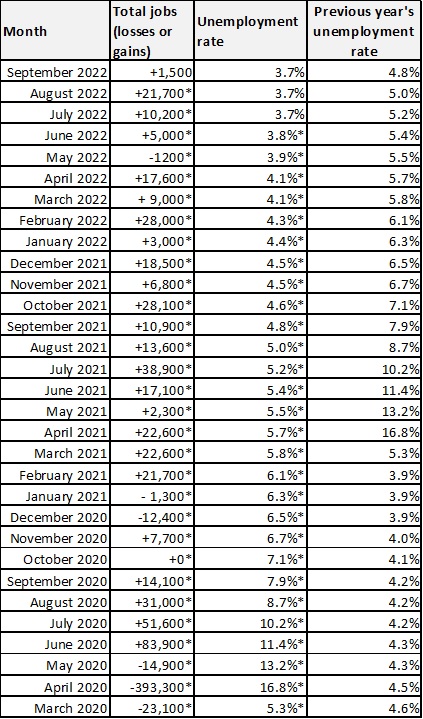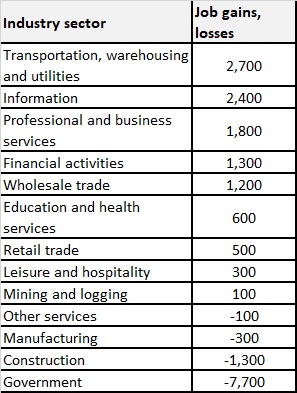September 2022 Monthly Employment Report
FOR IMMEDIATE RELEASE – Oct. 19, 2022
Contact: media@esd.wa.gov
Modest gains in state job growth in September
OLYMPIA – Washington’s economy gained an estimated 1,500 jobs (seasonally adjusted) in September. Job growth was highest in the following industries: Transportation, warehousing and utilities, information, professional and business services, financial activities and wholesale trade.
"September’s payroll employment numbers came in much lighter overall compared to August,” said the Employment Security Department’s (ESD) State Economist Paul Turek. “Together with the state’s historically low unemployment rate, the demand for workers is still very strong. The weaker employment numbers were concentrated in the public sector while private sector hiring remained strong.”
Visit ESD’s website to view the entire Monthly Employment Report for September.
ESD paid unemployment insurance benefits to 35,852 people in September, a decrease of 77 paid claims over the previous month. Decreases in paid claims within educational services, administrative and support services, waste management and remediation services contributed to the overall decrease in paid claims over the month.
National unemployment rate
The national unemployment rate decreased in September from 3.7% to a preliminary rate of 3.5%. For comparison, the national unemployment rate (revised) for September 2021 was 4.7%.
Updated preliminary data for August 2022
- The August 2022 preliminary estimated gain of 16,100 jobs was revised upwards to a gain of 21,700 jobs.
- The seasonally adjusted monthly unemployment rate for August was confirmed at 3.7% and remained constant in September.
Labor force participation modestly declines
The state’s labor force in September numbered 4,012,300 – a decrease of 8,100 people from the previous month. Labor force is defined as the total number of people, both employed and unemployed, over the age of 16.
In the Seattle/Bellevue/Everett region, the labor force decreased by 1,200 over the same period.
From September 2021 to September 2022, the state’s labor force increased by 73,300, while the Seattle/Bellevue/Everett region increased by 55,900.
From August to September, the number of people who were unemployed statewide increased from 149,200 to 150,200. In the Seattle/Bellevue/Everett region, the number of people who were unemployed increased from 46,200 to 47,500 over the same period.
Of the industry sectors, in September:
- Nine expanded
- Four contracted
Private sector employment increased by 9,200 jobs while government employment decreased by 7,700 jobs. The private sector and public schools are now regaining positions lost during the pandemic. However, state and local government jobs have been slower to rebound, mainly because workers, who were furloughed or laid off temporarily, haven’t returned to work. This is likely attributable to pandemic-related service reductions or recruiting challenges. Table 2 shows a summary of the job gains and losses in all 13 industry sectors.
Annual payroll growth is gradually slowing
Washington gained an estimated 161,100 jobs from September 2021 – September 2022, not seasonally adjusted. Private sector employment rose by 5.3%, up an estimated 151,500 jobs, while public sector employment rose by 0.4%, up an estimated 2,000 jobs.
From September 2021 – September 2022, ten major industry sectors expanded and three contracted
The three industry sectors with the largest employment gains year over year, not seasonally adjusted, were:
- Leisure and hospitality, up 32,900 jobs.
- Professional and business services, up 29,100 jobs.
- Education and health services, up 26,400 jobs.
Table 1: Washington’s total jobs

*Revised from previous preliminary estimates. Preliminary monthly estimates for job losses or gains are based on a small Bureau of Labor Statistics payroll survey. Actual figures reported the following month are based on a more complete survey.
Table 2: Job gains and losses by industry

Learn more about ESD’s monthly employment reports.
Every month, the Employment Security Department publishes preliminary seasonally adjusted estimates for the prior month’s job growth and unemployment. We also publish confirmed data for the month before last. See the entire Monthly Employment Report on our website.
Monthly Employment Report publication schedule for 2022
|
Preliminary data for the month of |
State and Seattle Metropolitan Division data released |
All other county data released |
|
October 2022 |
Nov. 16 |
Nov. 22 |
|
November 2022 |
Dec. 14 |
Dec. 20 |
|
December 2022 |
Jan. 18, 2023 |
Jan. 24, 2023 |
Labor market information
See more labor market information and tools, including interactive Tableau graphics, to highlight popular information and data.
WorkSource
Employment Security is a proud partner in the statewide WorkSource system, which provides employment and training assistance to job seekers and businesses. WorkSourceWA provides access to thousands of Washington jobs and other employment resources. WorkSource staff can connect job seekers with employers hiring right now in their community, identify training opportunities or help them brush up on application and interview skills. Job seekers and employers can find their nearest WorkSource center on the WorkSource office locator page.
U-6 unemployment rate
The U.S. Bureau of Labor Statistics (BLS) updated its “alternative measures of labor underutilization” for states to include annual averages for 2021. One such alternative measure is the U-6 rate, which considers not only the unemployed population in the official “U-3” unemployment rate, but also marginally attached workers and those employed part time for economic reasons. The U-6 rate is defined by BLS as the “total unemployed, plus all marginally attached workers, plus total employed part time for economic reasons, as a percent of the civilian labor force plus all marginally attached workers.” This U-6 measure measures the “unemployed, underemployed, and those who are not looking but who want a job.”
The U-6 unemployment rate for the four-quarter period from third quarter 2021 through second quarter 2022 for Washington state was 8.1 percent. This was lower compared to the 9.1 percent U-6 unemployment rate for the second quarter 2021 through first quarter period.
The U.S. U-6 unemployment rate for the four-quarter period from third quarter 2021 through second quarter 2022 was 7.6 percent.